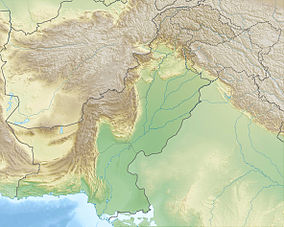Lal Suhanra is a national park in Pakistan that is situated in the Bahawalpur district of Punjab province. It is one of South Asia's largest nationals parks, and is a UNESCO declared Biosphere Reserve.[1] Lal Sohanra is notable for the diversity of its landscape, which includes desert, forest and wetland ecosystems.[2]
| Lal Suhanra National Park لال سہانرا نیشنل پارک | |
|---|---|
| Location | Punjab, Pakistan |
| Nearest city | Bahawalpur, Pakistan |
| Coordinates | 29°19′N 71°55′E / 29.317°N 71.917°E |
| Area | 65,791 ha |
| Established | 1972 |

There are archaeological remains of the ancient Indus valley civilization which once flourished along the Ghaggar-Hakra River (paleo Saraswati River).
Geography
editLal Suhanra National Park is situated some 35 kilometres east of Bahawalpur and presents a synthesis of forest and desert life.[2] It occupies land on both sides of Desert Branch canal, and is spread over 127,480 acres (51,590 hectares) of which 20,974 acres (8,488 hectares) are green land (irrigated plantations), 101,726 acres (41,167 hectares) are dry land (desert), and 4,780 acres (1,930 hectares) are wet land (ponds and lakes). The park's terrain is generally flat, interspersed with sand dunes measuring between 1 and 6 meters in height and occupying as many as thousands of acres apiece.[2]
The biosphere reserve is crossed by the dried-up bed of the Ghaggar-Hakra River and comprises Patisar Lake and irrigated land. Officials said that indigenous trees like Indian rosewood and Acacia karroo will be planted over 1,212 acres of barren land in the wildlife reserve.[3]
Wildlife
editMany species live throughout the park, including Asiatic wildcat, rabbit, bustard and deer. Reptiles in the park include the monitor lizard, Russell's viper, Indian cobra, saw-scaled viper, wolf snake, John's sand boa, and spiny-tailed lizard.[4]
Lion safari
editThe Punjab government has plans to convert Lal Sohanra National Park into a wildlife safari park of international standard. One of its most prominent attractions is the lion safari, which allows guests to see lions in their natural habitat at close range.[5]
See also
editReferences
edit- ^ "Lal Suhanra". UNESCO. Retrieved 28 December 2016.
- ^ a b c "Lal Suhanra National Park". Forest, Wildlife and Fisheries Department, Punjab. Retrieved 28 December 2016.
- ^ Abdul Manan (February 18, 2016). "PM Nawaz returns to old haunt to enjoy desert skies, music and milk". The Express Tribune. Retrieved 28 December 2016.
- ^ "Lal Suhanra National Park". Pakistan Tourism Portal. Retrieved 4 July 2022.
- ^ "Pakistan hopes Nepali rhinos will breed, multiply". SOS Rhino. Retrieved 28 December 2016.
